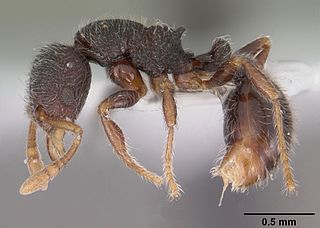
Myrmicinae is a subfamily of ants, with about 140 extant genera; their distribution is cosmopolitan. The pupae lack cocoons. Some species retain a functional sting. The petioles of Myrmicinae consist of two nodes. The nests are permanent and in soil, rotting wood, under stones, or in trees.

Cardiocondyla is an Old World genus of ants in the subfamily Myrmicinae.

Harpagoxenus is a genus of ants in the subfamily Myrmicinae. Found in the Palaearctic and Nearctic ecozones of the world, Harpagoxenus was first established as Tomognathus by Mayr (1861) to house the species Myrmica sublaevis. However, the name had already been used (homonym) for a genus of fish, and was replaced with its current name by Forel (1893).
Acromyrmex disciger is a species of leaf-cutter ant, a New World ant of the subfamily Myrmicinae of the genus Acromyrmex. This species is from one of the two genera of advanced attines within the tribe Attini. It is found in the wild naturally in Paraguay.
Acromyrmex nobilis is a species of leaf-cutter ant, a New World ant of the subfamily Myrmicinae of the genus Acromyrmex. This species is from one of the two genera of advanced attines within the tribe Attini.

Acromyrmex echinatior is a species of New World ants of the subfamily Myrmicinae of the genus Acromyrmex. It is found in the wild naturally from Mexico to Panama.

Eutetramorium is a small genus of ants within the subfamily Myrmicinae. To date it contains three species found in Madagascar and Comoros.

Agroecomyrmecinae is a subfamily of ants containing two extant and two fossil genera. The subfamily was originally classified in 1930 by Carpenter as Agroecomyrmecini, a Myrmicinae tribe. Bolton raised the tribe to subfamily status in 2003, suggesting that Agroecomyrmecinae might be the sister taxon to Myrmicinae. It has since been discovered to be one of the earliest lineages of ants, a clade from the basal polytomy for all ants. In 2014, the subfamily was expanded to two tribes. The tribe Ankylomyrmini was moved from the subfamily Myrmicinae to Agroemyrmecinae.

Agroecomyrmex is an extinct genus of ants in the formicid subfamily Agroecomyrmecinae, for which it is the type genus. The genus contains a single described species, Agroecomyrmex duisburgi. Agroecomyrmex is known from a group of Middle Eocene fossils which were found in Europe.

Cryptomyrmex is a genus of ant in the subfamily Myrmicinae. The genus is known from Brazil and Paraguay.

Blepharidatta is a rare Neotropical genus of ants in the subfamily Myrmicinae. The genus, formed by predatory species whose small colonies nest in soil or leaf-litter, has up to seven species, but most of them are waiting for a formal taxonomic treatment or confirmation.

Ochetomyrmex is a Neotropical genus of ants in the subfamily Myrmicinae.
Meranoplus parviumgulatus is a species of ant in the genus Meranoplus. It is known from New Guinea and Papua New Guinea.

Lasiomyrma is a South-East Asian genus of ants in the subfamily Myrmicinae. The genus is mainly known from tropical rainforests in Sundaland.

Proatta is a Southeast Asian genus of ants in the subfamily Myrmicinae. It contains the single species Proatta butteli, known from the Malay Peninsula, Borneo and Sumatra.

Tranopelta is a Neotropical genus of ants in the subfamily Myrmicinae.

Ankylomyrma is a genus of large arboreal ants in the subfamily Agroecomyrmecinae. It contains the single species Ankylomyrma coronacantha, the sole member of the tribe Ankylomyrmini. The genus is known from Africa. Nothing is known about their biology. The genus was moved from the subfamily Myrmicinae to Agroecomyrmecinae in 2014.

Lenomyrmex is a Neotropical genus of ant in the subfamily Myrmicinae.
Protanilla furcomandibula, formerly Furcotanilla furcomandibula, is a species of ant in the subfamily Leptanillinae. It is only known from Yunnan, China, where it nests in the soil and forages on the ground. Queens and males are unknown.















